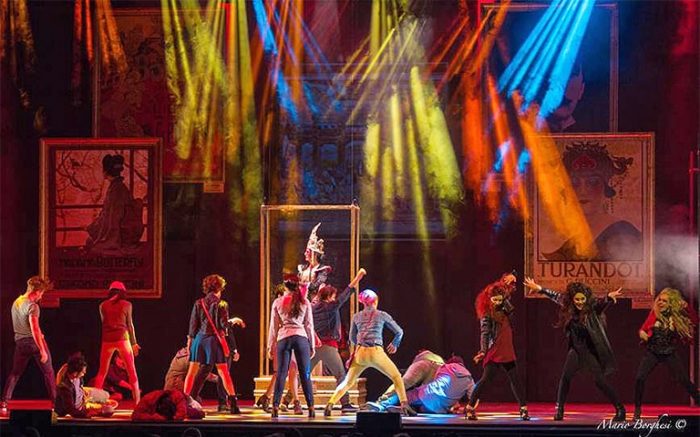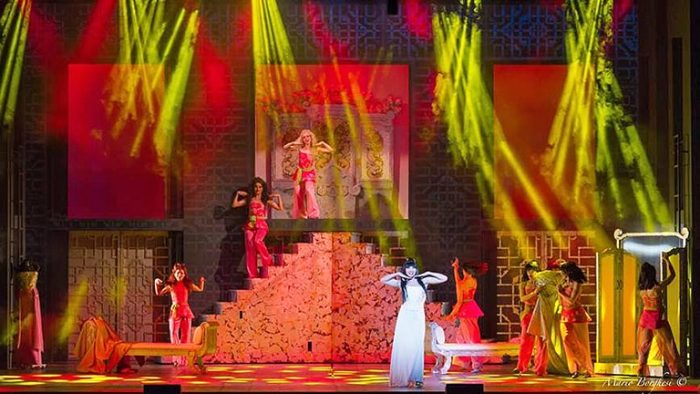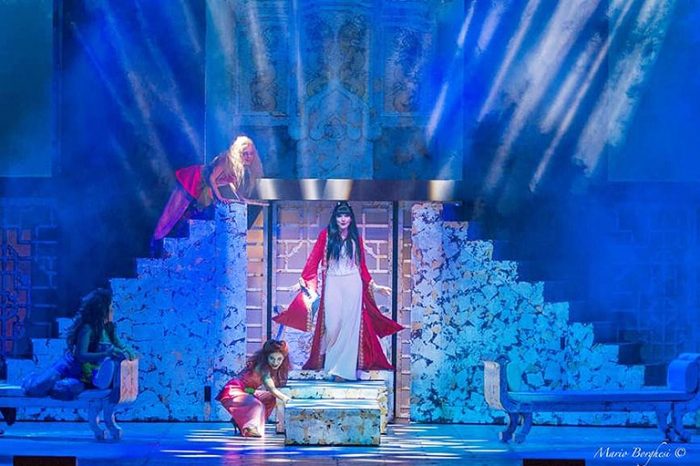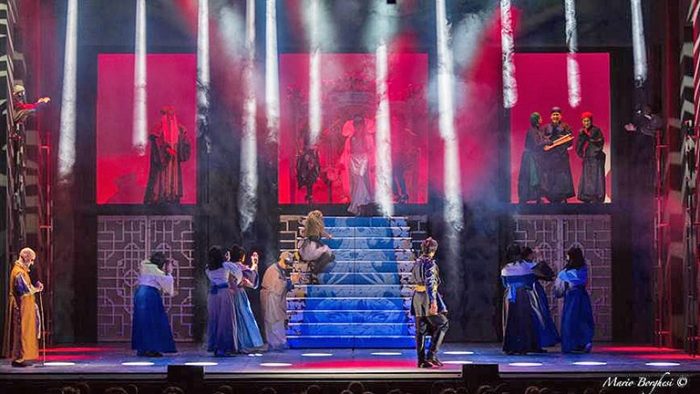The Queen of Ice: a success with DTS
A splendid Lorella Cuccarini plays the role of the evil queen in the musical inspired by Puccini’s Turandot, ‘The Queen of Ice’. The show is directed by Maurizio Colombi, who has already been the director of other very successful musicals, such as Rapunzel and Peter Pan.
Colombi gives an even more fantastic reading of the work that takes place in Beijing “at the time of fairy tales …” with the introduction of new characters close to the sensibility of a very young audience and using the most modern video mapping and lighting technologies.
The rental company Suono e Luci installed the RAPTOR beam moving heads and the NRG 1201 LED wash fixtures by DTS for this important production.
“I imagined for this musical strong color contrasts, many nuances for the narrative part, with colors tailored for every scene or environment” – told Alessio De Simone, Lighting Designer of ‘The Queen of Ice’ – “from the iced and dark winter of China (therefore a need for cold temperatures and shades from red to blue) to modern museums with paintings and glass cases (characterized by a warm orange and a 3200K key light), from the interior and exterior of houses and squares, to the happy ending – a triumph of light – with the return of the sun and the love that blossoms between the two protagonists.
The choice of lighting fixtures fell on the NRG 1201, placed on the side edges and on the trusses; I appreciated the multiple features of this versatile and compact LED moving head, from zoom to RGBW colors.
Also, after a careful comparison with other fixtures, I chose the RAPTORs, integrating them in the light plot as beam projectors and in some scenes as wash lights. The RAPTOR has these unique features, especially when you use the frost along with the prism. This configuration offers a wide and uniform beam, giving the lighting designers the powerful backlight they need for highly emotional scenes. No other competitor can offer this feature.”
We thank Alessio De Simone for his great courtesy and kindness.
Here below you can read the full interview where Alessio De Simone describes how he made the lighting design of the musical ‘The Queen of Ice’.
Interview with Alessio De Simone
“As is often the case – both in theater and in any other production – just before the actual stage design begins there is the most delicate and difficult phase, when you gather information from all the partners you’ll collaborate with to create the show.
The ‘Queen of Ice’ is a never-before-seen show that was created and constructed day after day by the artistic cast directed by Maurizio Colombi in close collaboration with Lorella Cuccarini, the real star of the show. There were no video or reference images for the lighting design, just a few sketches and a cardboard model; this left much room for creative imagination, giving me the opportunity to include in my drawing my vision of the lighting for a musical, based on the experience I made in recent years collaborating with other productions in this particular and fascinating field.
The artistic choice of the ‘Queen of Ice’ relies on a “fairy” concept, suitable for both a very young audience and a more experienced audience. I imagined strong color contrasts for this musical, with different nuances chosen for every scene or environment, with ninety percent of the show set in the iced and dark winter of China (therefore a need for cold temperatures and shades from red to blue) to modern museums with paintings and glass cases (characterized by a warm orange and a 3200K key light), from the interior and exterior of houses and squares to the happy ending – a triumph of light – with the return of the sun and the love that blossoms between the two protagonists.
After a confrontation with stage designer and director, I drew a first draft of the lighting design, outlining in principle the amount of projectors and their use, taking into account the “specials” that would characterize some scenes, key lights and standard effects that everybody expects in a high-level musical.
Usually this phase does not leave full freedom to the LD. Often the rental company recommends the LD to use the fixtures and equipments available in stock; other times the production manager tends to limit the artistic possibilities for budget reasons. For this production, both producer Carlo Buttò and Maurizio Mura (rental company manager) never imposed limits on my creative freedom, offering me their full collaboration in any aspect of the making.
The scenery (consisting of several two-story practicable elements, four side elements with windows, and a large rear structure with staircases and ‘dynamic’ doors) is mainly used for video projections of mapped images, with the addition of small elements that characterize each scene. Because of the the features of this “minimal” setup, I couldn’t light the stage backdrop, either directly or as a reflection, in order to let the viewers enjoy the exciting purpose-made pixel-mapped images. All the entrances of the actors on stage come from these rear doors, so in addition to keeping the projection clean, the need is to light the actors precisely and without reflections. An idea that proved to be effective during the creative stage at the Brancaccio Theater, though time consuming, as the director opted to keep the massive staircases on stage and consequently a special lighting for each scene had to be programmed; I created over 800 cues for the show.
The only possible choice was a light rig featuring both motorized and halogen shapers, as well as a series of wash light fixtures, to be used mainly in backlight, so as to avoid any reflection on the projections. The choice was the NRG 1201 wash light by DTS; it is versatile, compact and powerful and suits the needs of this show. I appreciated the multiple features of this LED moving head, from zoom to RGBW colors. The projectors have been placed on the side edges and on the trusses so that they could leverage the backlight in a uniform and accurate way; I often used color nuances degrading towards the stage backdrop, to create more depth. I sometimes split the stage into 2 or more areas, thus letting the audience focusing on the area of greatest interest, while keeping the rest of the scenic action visible.
At first I had chosen motorized shapers, as I needed lights that were not too powerful (for the aforementioned problem of the video projections). In a first evaluation, my choice turned to this type of fixture to cover both the role of shaper and of spot projector; but it turned out to be (also thanks to pre-programming with wysiwyg software) a poor performance solution. After a careful study and comparison with other fixtures, the choice fell on the RAPTOR moving heads, integrating them in the light plot as beam projectors and in some scenes as wash lights.
The RAPTOR has these unique features, especially when you use the frost along with the prism. This configuration offers a wide and uniform beam, giving the lighting designers the powerful backlight they need for highly emotional scenes. No other competitor can offer this feature. In my opinion, this is one of the strong points of the RAPTOR.
Also the prism delivers fantastic effects, and the color filters offer a softer choice than its competitors with nuances perfect for a theatrical show.
The movements are very fluid and the gobo change is so fast you can hardly perceive it.
This is not the first time I use DTS products; I am very fortunate to work in different lighting design areas, and I can say that RAPTOR, NRG and EVO are a great choice in any demanding situation, such as television and theatre.
After a few months since the first replica and just before a re-setup for a tour of the major Italian theaters, my review of the DTS products is very positive on the NRG 1201 and exceptional on the RAPTOR, which in my opinion is one of the best products on the market.
I would like to thank the whole team who worked on this fantastic project: my great colleague Claudio Cianfoni, Maurizio Colombi, Mario, Valerio, Danilo, Rita, Alessandro and the technical and artistic cast of the Ice Queen.”
- YEAR 2017
- Lighting DesignerAlessio De Simone
- Rental CompanySuono e Luci
- DirectionMaurizio Colombi
- Products involvedThe Queen of Ice: a success with DTS; RAPTOR








